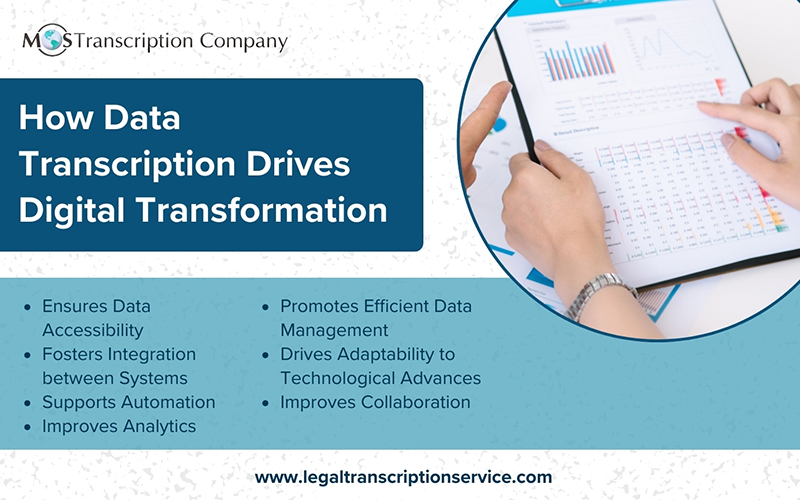There’s hardly any industry that hasn’t been impacted by digitalization. The adoption of digital processes have revolutionized the way organizations operate, enabling them to achieve greater levels of productivity, accuracy, and accessibility. Data transcription plays a key role in digital transformation. The process involves converting audio or video data into written or textual form. Businesses often rely on professional transcription services to ensure accurate documentation.
Transcribing your data is a foundational step that is critical for harnessing the benefits of digital solutions. Let’s see how data transcription drives digital transformation.
How Data Transcription supports Digital Transformation
Digital transformation has brought about significant improvements in operational efficiency across various industries, including healthcare, legal, finance, and media. Data transcription is the process of updating and organizing your data to match the requirements of digital storage systems. It ensures that your data can be stored, retrieved, and managed efficiently within the digital environment.
By transcribing your data and aligning it with digital protocols, you enhance the efficiency, interoperability, and overall effectiveness of your digital systems in various ways:
Digital Transformation
Transcribing company data into a digital format is a basis of the digital transformation journey. It allows businesses to move from manual, paper-based processes to automated and technologically advanced systems.
Data Accessibility
By digitizing data, transcription makes it easily accessible. Information can be quickly retrieved when needed, which is crucial for businesses looking to improve efficiency, decision-making processes, and overall productivity.
Integration between Systems
Many digital solutions require data in a structured and standardized format. Transcribing data into a digital format allows for smooth integration between different systems, promoting consistent and accurate data across multiple platforms.
Supports Automation
Automation requires digital data. By transcribing data into a machine-readable format, businesses open up opportunities for automation, reducing manual efforts, minimizing errors, and improving workflow efficiency.
Improved Analytics
Digital data is essential for meaningful analytics, helping organizations make data-driven decisions, identify patterns, and understand customers, operations, and the market. Advanced analytics techniques such as statistical analysis, machine learning, and predictive modeling extract actionable insights from digital data, leading to innovation, efficiency, and a competitive edge.
Efficient Data Management
Digital solutions such as Product Information Management (PIM) tools, Product Data Management (PDM) software, Enterprise Resource Planning (ERP) systems and others excel in managing vast amounts of data efficiently. An article published by AI Research and Analytics firm AIMultiple notes that for implementing these solutions, all company data has to be transcribed and converted into a digital format to make it machine-ready. Transcribing data into a digital format sets the stage for effective data governance, storage, and retrieval.
Adaptability to Technological Advances
As technology advances, businesses that have their data in a digital format can readily embrace new and advanced digital solutions. This prepares them for the future and allows them to maintain their competitiveness in a rapidly evolving technological environment. For example, a retail company that digitizes its inventory and sales data can leverage artificial intelligence (AI) algorithms to analyze customer preferences, optimize stock levels, and forecast demand, enabling them to make informed decisions and stay ahead of the competition.
Improved Collaboration
Digital data promotes teamwork within and outside the organization by enabling easy sharing, access, and collaboration on information and documents. With digital data, multiple team members can simultaneously work on the same document. For example, in a remote work scenario, team members can collaborate on a project by accessing and editing shared documents in a cloud-based platform. This eliminates the need for physical file sharing or lengthy email exchanges, allowing for efficient collaboration and enhancing productivity. Additionally, digital data can be securely shared with external stakeholders, such as clients, partners, or vendors, fostering collaboration and stronger business relationships.
It’s clear that transcribing company data and making it machine-ready is a foundational step for digital transformation. When transcribing company data into a digital format, there are some key points to consider.
Transcribing and Digitizing Company Data: Key Considerations
- Data assessment: The first step is conducting a thorough assessment of your company’s existing data. Identify the types of data that need to be digitized, such as product catalogs, customer information, financial records, inventory data, etc. This will help determine the scope and complexity of the digitization process.
- Data collection: Gather the relevant data from various sources, including physical documents, spreadsheets, databases, and other systems. Scan physical documents, extract data from electronic files, and integrate data from different systems.
- Data cleansing: Data cleansing involves removing any errors, inconsistencies, or duplicate entries. This step ensures the quality, integrity and reliability of your data before transcribing it into a digital format.
- Structure and format: Determine the appropriate data structure and format based on the requirements of the digital solution being implemented. This step may involve organizing material into databases, defining fields and attributes, and establishing data relationships.
- Data entry and conversion: Depending on the volume of data, manual or automated data entry methods can be used. Manual data entry involves transcribing data from physical documents or inputting data manually into the digital system. Utilizing automated data conversion techniques, such as Optical Character Recognition (OCR) or data extraction algorithms, can expedite the process.
- Data validation and migration: Validate the accuracy and completeness of the transcribed data by conducting data integrity checks. This step helps to identify and rectify any errors or discrepancies. Once the data is digitized and validated, it has to be migrated to the digital solution being implemented, such as a PIM tool, PDM software, or ERP system. This may involve data mapping, transformation, and loading processes to ensure seamless integration with the new system.
By converting your data into a digital form, you can streamline your workflow, improve data visibility, make better-informed decisions, and enhance operational efficiency. Partnering with digital transcription agencies to transcribe company data into a digital format is a proactive strategy for unleashing the full potential of digital solutions. Professional transcription companies have the expertise to handle large volumes of data and ensure its quality, setting the stage for successful digital transformation.
Transcribing your company data into a digital format is necessary to unlock the full potential of digital solutions, streamline your workflow, improve data visibility, enhance decision-making, and increase operational efficiency. Companies that have to manage a large amount of data work with digital transcription agencies to digitize it. Experts can ensure quality data, paving the way for digital transformation.
Step into the future with precise transcriptions tailored to your needs.





